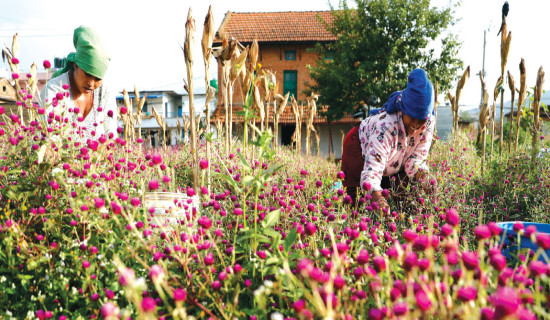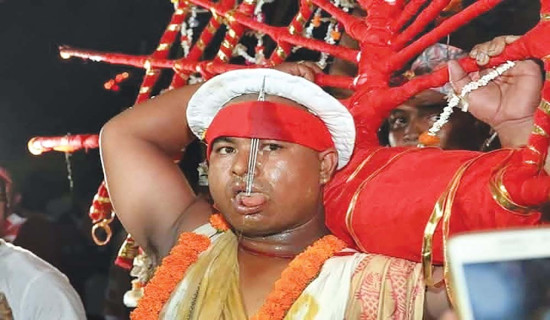- Monday, 5 January 2026
Women fast worshipping Lord Shiva on Shrawan Mondays
Kathmandu, July 21: As the auspicious month of Shrawan begins, the shimmer of green bangles and intricate henna designs decorate the hands of girls and women alike. From school-going students in a rural village to women in bustling cities, grace every alley and road with vibrant hues of devotion and tradition.
The markets are flooded with attractive green and yellow dresses, bangles and beaded necklaces (pote). The arrival of this sacred month has prompted Hindu devotees nationwide to begin their religious and cultural observance dedicated to Lord Shiva. Marked by visits to temples of Lord Shiva, observing a fast, and eating pure vegetarian food, Shrawan holds a special significance for devotees, particularly women.
Shrawan, the fourth month of the Hindu lunar calendar, is considered one of the most sacred periods in the Hindu tradition. Mondays, also known as Shrawan Sombar, are dedicated to Lord Shiva. Devotees keep a fast and offer prayers by pouring water, milk, honey and bel leaves on Shiva temples, especially Pashupatiath Temple in Kathmandu, Doleshwor Mahadev Temple in Bhaktapur, Gokarneshwar Mahadev Temple in Gokarna, Santaneshwar Mahadev Temple in Lalitpur, Kumbeshwar Mahadev Temple in Lalitpur, and Mahadev Temple of Hanumandhoka, among others in the Kathmandu Valley.
Sharmila Poudel, 49, a resident of Satikhel-3 in Dakshinkali Municipality, observed Shrawan Sombar fast and visited a nearby Shiva temple along with a group of women, wearing green attire, bangles and pote. The cultural trend to wearing green dress, bangles, pote and applying heena has gradually evolved, now embracing green adornments as a symbolic expression of harmony with nature, reflecting the lush greenery of the Shrawan month, she said.
Professor Dr. Nirmala Pokharel, a cultural expert, explained that Hindu scripture does not specifically mention the cultural importance of wearing the green colour.
"The trend of wearing all green has developed as a fashion and is associated with the natural green environment," she added.
The holy month is dedicated to Lord Shiva because the Samudra Manthan (Churning of the Ocean) took place in the month of Shrawan. During this time, the deadly Halahal poison emerged, which Lord Shiva consumed to save the universe. Each day of the week is dedicated to a specific god and goddess. Monday is dedicated to Lord Shiva in his honour, she explained. Alongside the spiritual observances, Shrawan holds rich cultural significance, particularly for women. Wearing green attire and bangles ha become a symbolic part of the month’s traditions, she said.
Another culture expert, Tajeshwor Babu Gong, explains that wearing all green during the holy month symbolises living in harmony with nature. With the changing patterns of society in observing festivals, the traditions have also changed, he added.
Applying heena (Mehendi) on hands is another prominent feature of this month, which is now widely practiced. Every junction and corner of the New Road area and other areas is filled with henna artists offering their services to passing women and girls. However, in earlier times, the paste of Tiuri (Balsam flower plant) was used to decorate the hands.
According to Ishwari Thapa, 71, from Surya Binayak Municipality-7, there was a tradition in the villages around Kathmandu of making a paste by mixing Tiuri leaves with other materials and applying it to the hands. Thapa still remembers her grandmother applying Tiuri during her childhood.
She explains that Tiuri is also worn to prevent skin diseases that occur while planting rice, working in the mud, or getting muddy during the months of Ashar and Shrawan.
It is believed that applying Tiuri paste during Shrawan not only helps prevent skin problems but also brings good fortune, she said.
Regarding the application of Tiuri, cultural expert Ganeshman Lachi said, "During the month of Shrawan, mothers, sisters, and female relatives make a paste from the leaves of the Turi flower and use it to create floral patterns on their hands and legs. This practice of applying Turi has been passed down for generations.
Shiva temples continue to draw thousands of pilgrims each week, and the streets become alive with women in green, henna-painted hands, and the echoes of devotional chants, symbolising a deep-rooted cultural harmony that blends faith and festivity.








-square-thumb.jpg)







